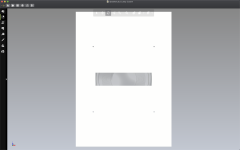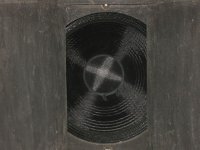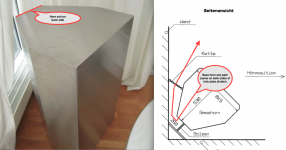In simple terms, it's a means of compression and has been used since long before these horns. Here is an Altec 828 FLH cabinet from before I was born. There are many examples of this including those right up to this day. It's shape likely has to do with it's similarity to the remaining horn pathway. IOW, it's good to control the air flow, it's not necessarily good to fight it or complicate it further.
Attachments
What is the function of the opening for the driver and why is it that shape and size?
Why is it rectangular?
Why is it not the shape and size of the driver?
IIRC, it was 13 inches by 3 inches. It sets the compression ratio.
The op post shows a single horn against floor/ceiling, a second depiction showing two up against a floor/wall interface, and a third showing four out in the open.
When I did mobile with 4 k horns, I used all three setups. It is important that adjoining cabs run in parallel to maintain acoustic loading.
Jn
Very odd. I recall seeing other diagrams, but now cannot find them. Am I losing it? The pic shows a three way, but at least the speakerlab version used a T-3000 tweeter(IIRC), which was about 4 inches length behind the baffle. Bad tweeter BTW, they overcompressed the lead in wire such that it would fail in heavy use. I toasted 8 of those puppies in a nightclub at the same time, ended up replacing them with 16 piezo's (do NOT ask me if I liked them)
Last edited:
If I use an 18” instead of a 15”, do I need to change the dimensions of the opening in order to change the compression ratio?
I'd expect to spend a little time with hornresp if you don't use the original driver. While you're there, see what it says about the output capability as it stands. You might not need to use such a large driver.
if you want an 18" version of the Klipschorn, then take a hornresp model and scale starting at 1.2X. Play with reducing back chamber volume to see tradeoff of excursion below cutoff vs excursion.
I'd imagine Eminence's Sigma18 would be functional as would be a few other pro 18" woofers.
University's "Classic" models much like the Khorn but is already huge. Scaled 1.2x for an 18" speaker it would be about 48" x 36" x 29".
I think I once asked PWK in a letter about an 18" version of the Khorn and he basically didn't think it would have any advantages. That said, there was the EV Patrician IV and Ben Drisko's 18 inch "Driskhorn" (which had differening flare rates)
By "scale starting at 1.2X" I'm guessing you mean to add each dimension of the klipschorn by 1.2
That makes perfect sense to me (15x1.2=18).
What doesn't make sense to me is how Martion's Orgon bass is smaller than the Klipschorn when he uses a larger driver...
About the 18-inch driver, seems that again some horn logic is being overlooked.
A true corner horn (in a true corner) plays really loud with a 15-inch driver. And Kllipsch used to say all he needed was a clean 5 watts.
With any other enclosure, I'd say driver resonance is the key parameter. If the horn is true, not so critical here but a 15-inch likely to be better in all kinds of ways than an 18-inch.
I'd guess that you'd want a stiff cone material. Again, 15 being better.
BTW, I always kept a cement cinderblock or a wine rack on top of mine.
B.
A true corner horn (in a true corner) plays really loud with a 15-inch driver. And Kllipsch used to say all he needed was a clean 5 watts.
With any other enclosure, I'd say driver resonance is the key parameter. If the horn is true, not so critical here but a 15-inch likely to be better in all kinds of ways than an 18-inch.
I'd guess that you'd want a stiff cone material. Again, 15 being better.
BTW, I always kept a cement cinderblock or a wine rack on top of mine.
B.
I see the rather small listed dimensions of the Orgon as
22.8 W x 38.6 H x 21” D
You could take a K-horn hornresp model and muck with it for that bulk while modifying "something" (that cutaway drawing may not exactly represent Orgon's innards) That width would pretty much preclude the "ramps" but it may have some expansion between the front panel and rear chamber shape.
From two models of the Khorn, it can have 63 or 81 liters back chamber volume. That probably is enough for some 18 inch drivers.
Does Orhorn basshorn use active equalization?
For a somewhat easier to cut cornerhorn there was the "Eckhorn18"
Lautsprecherbausatz Eckhorn 18
http://pics.poisonnuke.de/upload/119/eckhorn2.jpg
AJ Horn Eckhorn18 simulation
http://www.aj-systems.de/sim/Eckhorn18.gif
22.8 W x 38.6 H x 21” D
You could take a K-horn hornresp model and muck with it for that bulk while modifying "something" (that cutaway drawing may not exactly represent Orgon's innards) That width would pretty much preclude the "ramps" but it may have some expansion between the front panel and rear chamber shape.
From two models of the Khorn, it can have 63 or 81 liters back chamber volume. That probably is enough for some 18 inch drivers.
Does Orhorn basshorn use active equalization?
For a somewhat easier to cut cornerhorn there was the "Eckhorn18"
Lautsprecherbausatz Eckhorn 18
http://pics.poisonnuke.de/upload/119/eckhorn2.jpg
AJ Horn Eckhorn18 simulation
http://www.aj-systems.de/sim/Eckhorn18.gif
Last edited:
Here's the late Dr. Bruce Edgar's take on PWK's "rubber throat" plus comments on his articles
Article: Solving the Klipschorn Throat Riddle (Edgar) - Technical/Modifications - The Klipsch Audio Community
btw, with passive crossovers, the Klipschorn AK network added a shunt capacitor to "boost" response in the crossover region by pulling more power from solid state amplifiers. That will not work with high output Z amplifiers.
Here that's shown with his "LB76"
https://patentimages.storage.googleapis.com/16/e0/3e/31054950938644/US4237340.pdf
Article: Solving the Klipschorn Throat Riddle (Edgar) - Technical/Modifications - The Klipsch Audio Community
btw, with passive crossovers, the Klipschorn AK network added a shunt capacitor to "boost" response in the crossover region by pulling more power from solid state amplifiers. That will not work with high output Z amplifiers.
Here that's shown with his "LB76"
https://patentimages.storage.googleapis.com/16/e0/3e/31054950938644/US4237340.pdf
Last edited:
In simple terms, it's a means of compression and has been used since long before these horns. Here is an Altec 828 FLH cabinet from before I was born. There are many examples of this including those right up to this day. It's shape likely has to do with it's similarity to the remaining horn pathway. IOW, it's good to control the air flow, it's not necessarily good to fight it or complicate it further.
Since the cabinet is completely sealed, what happens when the airflow finally stops?
I’m trying to wrap my head around this...
Do the walls of the cabinet become the new resonators?
Last edited:
oh well...it's filed under quantum phisics and it's a territory that amuses me but I don't have the authority to explain it. But as long as the air is made of molecules and atoms and resides in the real world, I thought it would have been useful to show it.
I thought we were talking about horns where air gets compressed ( and rarefaction appears at the next semi-cycle) ...
I thought we were talking about horns where air gets compressed ( and rarefaction appears at the next semi-cycle) ...
Simonsig,Since the cabinet is completely sealed, what happens when the airflow finally stops?
Do the walls of the cabinet become the new resonators?
2)What is the function of the opening for the driver and why is it that shape and size?
3)Why is it rectangular?
4)Why is it not the shape and size of the driver?
The Martion Orgon cabinet is not completely sealed, it is open on the back, similar to the Klipsch corner horn. The cabinet walls are not resonators, they form the inner portion of the corner horn. The corner completes the horn, using a "bolzen" (kick plate reflector) in the area between the FLH cabinet and corner walls for a smoother transition between the two.
This type of "corner" FLH (front loaded horn) has a gradual (exponential) expansion of cross section area through several different bends.
The horn throat is reduced to less than the driver's Sd (surface area of the driver) to achieve a higher compression ratio, using less cabinet volume than a large throat would require.
Higher compression ratios result in higher horn efficiency.
Art
Attachments
Do you have an 18" driver to recommend? If I had endless resources for the driver, how could I get as close as possible to the Orgon bass? What do you think he uses?
He uses a custom made RCF woofer. The custom feature mainly being low Fs.
In simple terms, it's a means of compression and has been used since long before these horns. Here is an Altec 828 FLH cabinet from before I was born.
In the Klipschorn the slot is tiny compared to the driver so I always assumed that it does create a compression chamber but with Altec I assumed that there isn't much compression going on and I thought it was mostly to widen dispersion in order to change it from conical (above 700-800Hz) so it can be shaped into the nominal 90x40 over it's entire operating range.
Am I wrong? I've never bothered to calculate it properly, it's just what it seemed like to me.
- Home
- Loudspeakers
- Subwoofers
- What does this "bass horn" actually consist of?



